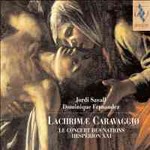
Lachrima Caravaggio
 $35.00
Out of Stock
$35.00
Out of Stock6+ weeks add to cart
JORDI SAVALL
Lachrima Caravaggio
Ferran Savall (vocals) / Le Concert des Nations / Hesparion XXI / Jordi Savall
[ Alia Vox / SACD ]
Release Date: Wednesday 6 June 2007
This item is currently out of stock. It may take 6 or more weeks to obtain from when you place your order as this is a specialist product.
This new production from Alia Vox is a novelty in more ways than one. Almost all the music has been written by Jordi Savall, including a number of compositions and improvisations based on arrangements of works by Gesualdo, Monteverdi and Trabaci.
Hybrid/SACD - playable on all compact disc players
"Lachrimæ Caravaggio is a long work; and though there are easily recognized repeated sections that tie it all together, and episodes of animated, dance-like music that provide contrast, the overall impression tends to be one of a piece that is somewhat drone-like and relatively static. It's hard to say exactly to whom Savall's opus will appeal. I found it pleasing in a mood-evoking way, but it's not something I'd likely listen to repeatedly."
(Fanfare October 2007)
This new production from Alia Vox is a novelty in more ways than one. Almost all the music has been written by Jordi Savall, including a number of compositions and improvisations based on arrangements of works by Gesualdo, Monteverdi and Trabaci. It is also an unprecedented encounter between a writer and a musician, both inspired by the figure of a painter. Focussing on seven of the artist's most disturbing works and seven musical 'stanzas', respectively, the French writer Dominique Fernandez and Jordi Savall pay an impassioned tribute to this extraordinary artist through their own literary and musical perspectives on the genius of Caravaggio. Although the instrumental line-up in these compositions has its origins in the 17th century, both the musical language and expression are firmly rooted in the 21st century, Savall pays tribute to such modern composers such as Arvo Pärt, particularly in his approach to improvisation and dissonance, crossing genres, periods and disciplines. As always, Alia Vox presents a lavishly documented album, graced by a wealth of carefully selected illustrations.
Tracks:
SAVALL Lachrimæ Caravaggio • Jordi Savall (gambe), cond; Ferran Savall (voc); Riccardo Manasi (violon); Andrew Lawrence-King (arpa doppia); Xavier Puertas (violone); Le Concert des Nations; Hespèrion XXI • ALIA VOX 9852 (77:41)
Jordi Savall, Dominique Fernandez: Lachrimae Caravaggio [Hybrid SACD
Audio CD; Hybrid SACD
Alia Vox Spain
Buy now from AmazonAt first glance-a cover painting of the Virgin Mary grieving over the body of the crucified Christ, a sumptuous 167-page booklet in four languages, the Latin title of the work, and the period-practices ensembles that specialize in early music-one would have expected this release to appear under J. F. Weber's reviewing byline. But as always, appearances can be deceiving. The music, albeit written in styles ranging from the late medieval and Renaissance periods to the early Baroque, is by a composer, conductor, and viola da gamba-player, Jordi Savall, who is very much alive. Though it is quite beautiful and affecting, the question that certainly comes to mind is why any composer living in the 21st century would want to write music that, for long stretches, resembles the lute songs of John Dowland, the "chest of viols" consort compositions of the late 16th century, and the emotionally tortured chromatic Italian madrigals of Gesualdo.
As Savall's Lachrimæ Caravaggio unfolds in large multisectional movements representing the Stations of the Cross, one comes to understand the work as an effort to depict the enigmatic, often grotesque, and deeply disturbing religious paintings of Michelangelo Merisi da Caravaggio (1571-1610) in a musical language that corresponds chronologically to contemporary music of his time. The "Sinfonia di Guerra" from Statio II, for example, is based on a piece by Monteverdi; the aria, recitative, and lament from Statio III is drawn from Alessandro Stradella and Luigi Rossi; and the "Durezze ligature" from Statio IV is derived from the more obscure Giovanni Maria Trabaci (1575-1647).
Whether or not there is any significance to the fact that Savall chose as one of his sources Stradella, who was murdered, it is apparent that the music speaks to the violent, tormented, and twisted images of Caravaggio's last paintings that Dominique Fernandez's texts and Savall's score set out to portray. For such a lavishly produced booklet that already contains several high quality color photographs and a running chronology of the painter's life, it would have been nice had Alia Vox obtained the rights to reprint photos of the seven canvases named. Less understandable for a production of such extravagance is the omission of Fernandez's texts. There are important vocal parts incorporated into the work, but I can only guess at what the singers are intoning and sometimes wailing about.
Lachrimæ Caravaggio is a long work; and though there are easily recognized repeated sections that tie it all together, and episodes of animated, dance-like music that provide contrast, the overall impression tends to be one of a piece that is somewhat drone-like and relatively static. It's hard to say exactly to whom Savall's opus will appeal. I found it pleasing in a mood-evoking way, but it's not something I'd likely listen to repeatedly. Jerry Dubins


